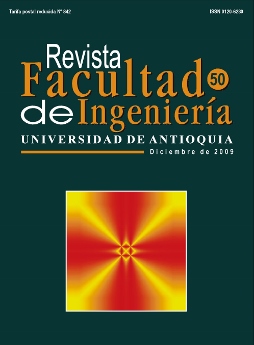Clasificación de la agresividad atmosférica en Colombia mediante métodos estadísticos multivariados
DOI:
https://doi.org/10.17533/udea.redin.14930Palabras clave:
agresividad atmosférica, corrosión, métodos estadísticos multivariados, sector eléctrico colombiano, aceroResumen
Los estudios de corrosión atmosférica, a menudo, requieren una clasificación de las atmósferas en función de su agresividad, lo cual implica el procesamiento de una gran cantidad de datos relacionados con variables meteorológicas y de contaminación. En este trabajo se realizó una clasificación de diferentes atmósferas colombianas, bajo las cuales se encuentran las principales líneas de transmisión eléctrica, mediante el método de análisis de cluster, teniendo en cuenta información meteorológica. Con base en esta clasificación, se eligieron 21 sitios representativos para realizar mediciones en campo de la corrosión del acero y el acero galvanizado, la concentración de SO2 y cloruros, la temperatura y el tiempo de humectación. Con esta información, se clasificaron nuevamente las atmósferas y se establecieron relaciones entre las variables atmosféricas, el tiempo de exposición y la corrosión, empleando modelos de regresión y métodos estadísticos multivariados.
Descargas
Citas
C. Leygraf, T. Graedel. Atmospheric Corrosion., Ed. Wiley. New York. 2000. pp. 9-65.
V. Kucera, E. Mattsson. “Atmospheric corrosion”. F. Mansfeld. Corrosion Mechanisms. Ed. Marcel Dekker. New York. 1987. pp. 211-284.
International Organization for Standardization. Corrosion of Metals and Alloys – Corrosivity of Atmospheres: Classification. Geneva. ISO. (Norma: ISO 9223). 1992. pp. 1-13.
J. Tidblad, A. Mikhailov, V. Kucera. “A Model for Calculation of Time of Wetness Using Relative Humidity and Temperature Data”. Proceedings 14th International Corrosion Congress. Cape Town. South Africa. 1999. pp. 1-10.
P. W. Brown, L.W. Masters. “Factors Affecting the Corrosion of Metals in the Atmosphere”. W. H. Ailor. Atmospheric Corrosion. Ed. John Wiley and Sons. New York. 1982. pp. 31-50.
J. A. Rocha. “Atmospheric Corrosion at High Altitudes Over Sea Level”. Proceedings 15th International Corrosion Congress. Granada. 2002. pp. 1-8.
M. Morcillo, E. Almeida, B. Rosales, J. Urruchurtu, M. Marrocos. Corrosión y Protección de Metales en las Atmósferas de Iberoamérica, Parte I. CYTED. Madrid. 1998. pp. 1-54.
M. Morcillo, B. Chico, L. Mariaca, E. Otero. “Salinity in Marine Atmospheric Corrosion: Its Dependence on the Wind Regime Existing in the Site”. Corros. Sci. Vol. 42. 2000. pp. 94-101. DOI: https://doi.org/10.1016/S0010-938X(99)00048-7
D. E. Jonson. Métodos Multivariados Aplicados al Análisis de Datos. Ed.Thomson. México. 2000. pp. 93-485.
ASTM. Standard Test Methods for Evaluation of Total Sulfation Activity in the Atmosphere by the Lead Dioxide Technique. West Conshohocken, PA. ASTM (Norma: ASTM D-2010). 2004. pp. 1-6.
ASTM. Standard Test Method for Determining Atmospheric Chloride Deposition Rate by Wet Candle Method. West Conshohocken, PA. ASTM (Norma: ASTM G-140). 2002. pp. 1-4.
ASTM. Standard Practice for Preparing, Cleaning, and Evaluating Corrosion Test Specimens. West Conshohocken. PA. ASTM (Norma: ASTM G-1). 1999. pp. 1-7.
A. Valencia, C. Arroyave, J. Minotas, R. Pérez. “Avances en los Estudios de Corrosividad Atmosférica en Colombia”. Rev. Fac. Ing. Univ. Antioquia. Vol. 13. 1996. pp. 32-42.
F. Corvo, J. Minotas, J. Delgado, C. Arroyave. “Changes in Atmospheric Corrosion Rate Caused by Chloride Ions Depending on Rain Regime”. Corros. Sci. Vol. 47. 2005. pp. 883–892. DOI: https://doi.org/10.1016/j.corsci.2004.06.003
D. de la Fuente, J. G. Castaño, M. Morcillo. “Longterm Atmospheric Corrosion of Zinc”. Corros. Sci. Vol. 49. 2007. pp. 1420-1436. DOI: https://doi.org/10.1016/j.corsci.2006.08.003
Descargas
Publicado
Cómo citar
Número
Sección
Licencia
Derechos de autor 2018 Revista Facultad de Ingeniería

Esta obra está bajo una licencia internacional Creative Commons Atribución-NoComercial-CompartirIgual 4.0.
Los artículos disponibles en la Revista Facultad de Ingeniería, Universidad de Antioquia están bajo la licencia Creative Commons Attribution BY-NC-SA 4.0.
Eres libre de:
Compartir — copiar y redistribuir el material en cualquier medio o formato
Adaptar : remezclar, transformar y construir sobre el material.
Bajo los siguientes términos:
Reconocimiento : debe otorgar el crédito correspondiente , proporcionar un enlace a la licencia e indicar si se realizaron cambios . Puede hacerlo de cualquier manera razonable, pero no de ninguna manera que sugiera que el licenciante lo respalda a usted o su uso.
No comercial : no puede utilizar el material con fines comerciales .
Compartir igual : si remezcla, transforma o construye a partir del material, debe distribuir sus contribuciones bajo la misma licencia que el original.
El material publicado por la revista puede ser distribuido, copiado y exhibido por terceros si se dan los respectivos créditos a la revista, sin ningún costo. No se puede obtener ningún beneficio comercial y las obras derivadas tienen que estar bajo los mismos términos de licencia que el trabajo original.










 Twitter
Twitter